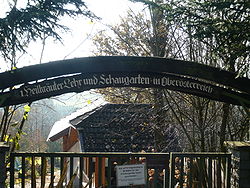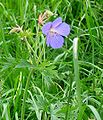Medicinal herb garden Klaffer am Hochficht
| Medicinal herb garden | |
|---|---|
| place | Klaffer on the Hochficht |
| Number of visitors | 6,000 per year |
| founder | Pastor Norbert |
| completion | August 15, 1980 |
The medicinal herb garden Klaffer am Hochficht is today the largest medicinal herb garden in Austria .
location
The medicinal herb garden Klaffer am Hochficht is located in the Rohrbach district in the northern Mühlviertel near the Hochficht ski area . Coming from the south you will find the medicinal herb garden just after entering the town on the left side behind the parish church of Klaffer am Hochficht.
history
Pastor Norbert Johann Pühringer began in the 1970s with the support of voluntary community citizens to create today's medicinal herb garden in the community of Klaffer am Hochficht. The work lasted from 1970 to 1978. The project was completed under the direction of Angela Hehenberger in August 1980 and opened on August 15, 1980 by Mayor Robert Egginger. The medicinal herb garden has been constantly expanded in recent years and now covers an area of around 7,800 m² on which around 1,000 different medicinal herbs grow and thrive. Today the medicinal herb garden is run by the association " Operation for the maintenance and promotion of the 1st Upper Austrian medicinal herbs, show and teaching garden Klaffer " under the direction of chairman Rupert Mager. On November 7, 1994, the Upper Austrian provincial government awarded the association the environmental protection special prize 1994 ("natural home gardens"), which was founded on the proposal of the panel of judges. The medicinal herb garden registers around 6000 visitors per year.
Founder of the medicinal herb garden
Norbert Johann Pühringer was born on July 30, 1908 in Wels - Lichtenegg. Pastor Norbert was already in charge of Klaffer's pastoral care from January 1, 1941 until the inauguration of Klaffer's first church on January 11, 1958. On January 11, 1958, he became the first pastor of the Klaffer parish on Hochficht. In 1950 the pastor caught severe colds which led to paralysis ( polyarthritis ). In his room at the Wels hospital there were two other patients who suffered from the same disease and were treated with gold injections and many drugs. he refused and was supported by his sister Aretha, who worked in the hospital. She spread well-boiled, hot hay flowers on all joints, wrapped him in linen and covered the bedspread with a plastic sheet. After two to three hours of intense sweating, his sister bathed him, after which he needed a lot of rest and sleep.
After six months the pastor left the hospital cured and without pain. The hay flowers had released the tension in his joints, supposedly by pulling the toxins out of the joints and thus healing the inflammation. The pastor then acquired a great deal of specialist knowledge in this specialist area and held lectures with naturopaths. During this time he developed the plan for the medicinal herb garden, which he was then able to implement. On September 1, 1979, he handed over the parish of Klaffer am Hochficht to Pastor Dominik Höglinger and retired. Pastor Norbert died during his 10th pilgrimage to Lourdes on October 3rd, 1989 in the monastery of Saint Gildard in Nevers (France) of a heart attack at the age of 82.
society
The association for the operation, maintenance and promotion of the 1st Upper Austria. Medicinal herbs, show and teaching gardens Klaffer is based in Klaffer and wants to fulfill three tasks:
- Promotion and promotion of popular education and educational work (school, excursions)
- To offer science the opportunity for research and to be able to do research itself.
- To appreciate and preserve medicinal plants, herbs and shrub plants, especially the species threatened with extinction.
The association is headed by the chairman Rupert Mager. In addition to the chairman, there are also the organs of the general meeting, the board of directors and the auditor. In addition to the membership fee, the medicinal herb garden is financed through donations, subsidies from the community and income from events. Such events were, for example, two herb festivals. In the summer of 2010, the association held another herb festival to mark the 30th anniversary. Every year on August 15, the herb consecration takes place with a Holy Mass.
Design of the garden
The medicinal herb garden Klaffer a. H. is divided into different beds. Between the different beds there is a heather landscape , bushes, trees, a pond and opportunities to rest. At the entrance next to the cash register there is a wayside shrine dedicated to Saint Hildegard von Bingen . In the lower area there is a cottage garden with fresh vegetables and fruits as well as traditional flowers. In the middle of the farmer's garden there is a spice island with different kitchen herbs and spices. The tree of life stands below the cottage garden . Next to the cottage garden are the monthly garden and the single garden. The monthly garden is divided into twelve small beds with herbs typical of the month in question. The single garden contains a balanced range of herbs and vegetables for single households. Many different types of orchids can be seen above the monthly garden . Opposite the cottage garden is the fallow plot. Nothing is planted here by the employees of the medicinal herb garden. Due to the flight of seeds and wind, plants plant themselves here independently. There is a bee showcase between the pond and the educational garden. Here you can watch the bees and the queen bee , which can be easily distinguished from the other bees by their size and markings , in the hive. Above the heather there is a large resting place, where the annual Holy Mass with herb consecration takes place in mid-August.
Description of the main beds
The most important garden area is the show and teaching garden in the center of the medicinal herb garden. In this bed are the kitchen herbs, the medicinal herbs, the tea garden and the mint bed. These beds contain local medicinal plants.
| Culinary herbs | Botanical name |
|---|---|
| Sweet root | Sium sisarum |
| Fragrant leeks | Allium suaveolens |
| hyssop | Hyssopus officinalis |
| Lemon thyme | Thymus citriodorus |
| Summer purslane | Portulaca oleracea |
| Chives | Allium tuberosum |
| Leek onion | Allium fistulosum |
| basil | Ocimum basilicum |
| Mustard cress | Lepidium latifolium |
| Garden sage | Salvia officinalis |
| oregano | Origanum vulgare |
| Bärwurz | Ligusticum mutellina |
| Lovage | Levisticum officinale |
| Borage | Borago officinalis |
| Nasturtiums | Tropaeolum majus |
| Japanese parsley | Cryptotaenia japonica |
| marjoram | Majorana hortensis |
| Tree spinach | Chenopodium giganteum |
| Horseradish horseradish | Armoracia rusticana |
| chives | Allium schoenoprasum |
| Wild thyme | Thymus serpyllum |
| Mountain savory | Satureja montana |
| Sweet umbel | Myrrhis odorata |
| Tea garden | Botanical name |
|---|---|
| Garden sage | Salvia officinalis |
| Ribwort plantain | Plantago lanceolata |
| Perforated St. John's Wort | Hypericum perforatum |
| Gold balm | Monarda didyma |
| Wormwood | Artemisia absinthium |
| Field horsetail | Equisetum arvense |
| Roman chamomile | Chamaemelum nobile |
| Common lady's mantle | Alchemilla vulgaris |
| Alpine women's coat | Alchemilla alpina |
| Lemon balm | Melissa officinalis |
| Apple mint | Mentha spicata |
| yarrow | Achillea tomentosa 'Aurea' |
| Small-flowered willowherb | Epilobium parviflorum |
| Big nettle | Urtica dioica subsp. dioica |
| Marshmallow | Althaea officinalis |
| Pineapple sage | Salvia rutilans |
| Woman sage | Tanacetum balsamita |
| Lungwort | Pulmonaria longifolia |
| Variegated sage | Salvia officinalis 'Icterina' |
| Caucasian Comfrey | Symphytum caucasicum |
| oregano | Origanum vulgare |
| Mint bed | Botanical name |
|---|---|
| Catnip | Nepeta cataria |
| Apple mint | Mentha spicata |
| Pineapple mint | Mentha suaveolens |
| Ginger mint | Mentha × gracilis |
| Orange mint | Mentha aquatica f. citrina |
| Spearmint | Mentha spicata subsp. crispa |
| Mountain mint | Calamintha nepeta |
| peppermint | Mentha × piperita var. Piperita |
| Chocolate mint | Mentha × piperita 'Chocolate' |
| Spearmint | Mentha spicata |
| Small-flowered mountain mint | Calamintha nepeta |
| Medicinal herbs | Botanical name |
|---|---|
| Plantain | Plantago major |
| Pointed Plantain | Plantago lanceolata |
| Five-finger herb | Potentilla reptans |
| Upright Ziest | Stachys recta |
| Oriental poppy | Papaver orientale |
| lavender | Lavandula angustifolia |
| Or poor | Argrimonia eupatoria |
| Marigold | Calendula officinalis |
| Feverfew | Tanacetum parthenium |
| Weaver card | Dipsacus sativus |
| Motherwort | Leonurus cardiaca |
| Houseleek | Sempervivum tectorum |
| Fingerwort | Potentilla anserina |
Another highlight is the Alpinum I and the Alpinum II . These beds contain plants from the Alps , some from the high mountains. The Alpinum is designed in such a way that it partly has a high mountain character. The heyday of the alpine plants is between May and June. In Alpinum I are, for example, the Alpenglöckchen that Pasque , the pantograph , the dwarf Korean fir or the Goldprimel . In Alpinum II can be found, among other things different types of gentian , which in Austria under conservation are.
literature
- Klaffer a. H. (Ed.): Life picture of Norbert Johann Pühringer. Community archive Klaffer a. H.
- Community archive Klaffer a. H. (Ed.): Father Norbert's hay flower pack.
Individual evidence
- ↑ a b c d e Klaffer cultural community a. H. (Ed.): Life picture of Norbert Johann Pühringer. Community archive Klaffer a. H.
- ↑ a b Klaffer herbal parish celebrates its 50th anniversary ( page can no longer be accessed , search in web archives ) Info: The link was automatically marked as defective. Please check the link according to the instructions and then remove this notice. on www.dioezese-linz.at. Retrieved November 13, 2009.
- ↑ Klaffer Herb Garden - Klaffer Herb Garden
- ↑ municipal archives Klaffer aH (ed.): Father Norbert's hayflower
- ↑ Municipality of Klaffer am Hochficht
Web links
Coordinates: 48 ° 41 ′ 34.1 ″ N , 13 ° 53 ′ 1 ″ E








